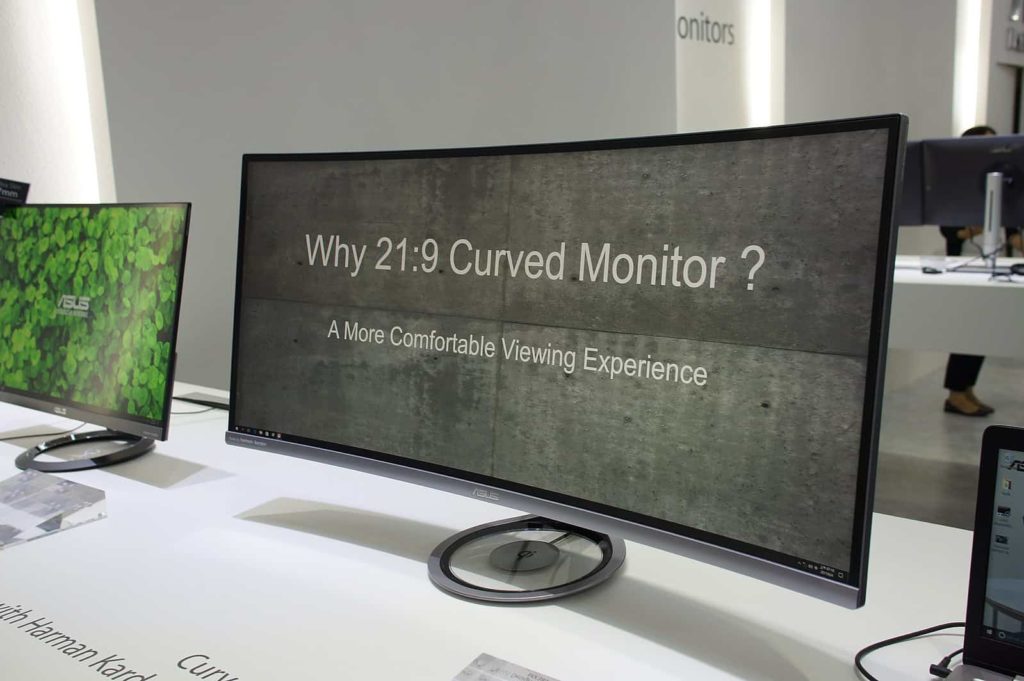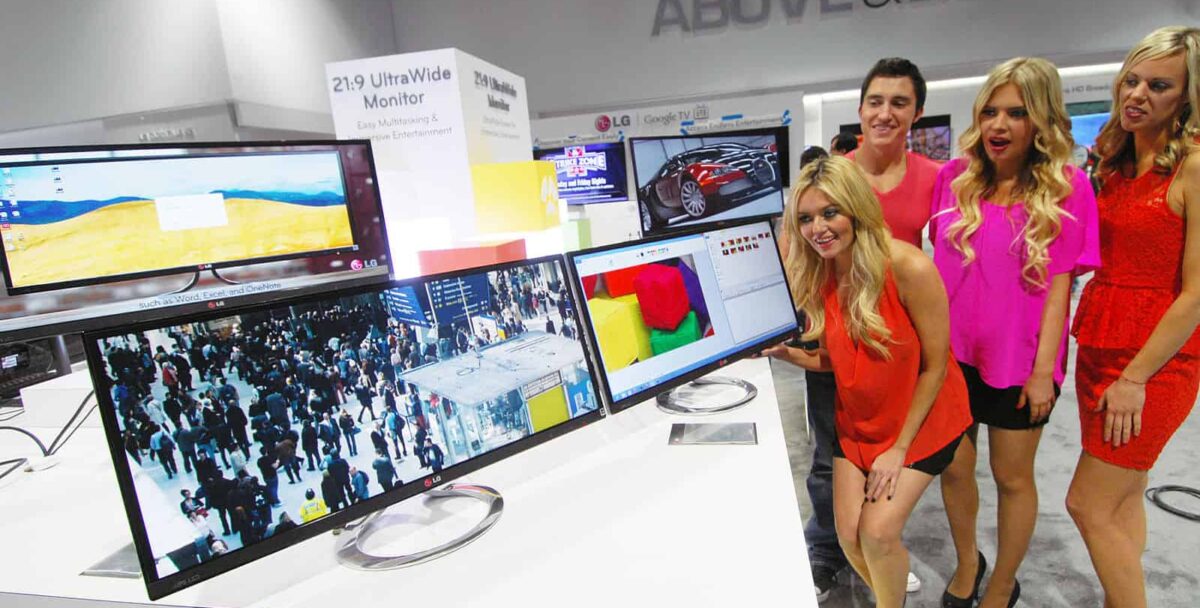As video conferencing technology has grown in the past few years, so has the need for new monitor technology.
Many companies are turning to 21:9 ultrawide monitors to help give their in-person viewers of video conferences a more immersive, personal experience.
What are 21:9 ultrawide monitors, and how can your company use them?
We’ll define ultrawide monitors and how they are the future of video conferencing and office work.
Related: 3 New Trends in Immersive Experience to Watch
What Are Aspect Ratios?
Let’s talk about how and why aspect ratios are important. The term aspect ratio refers to the width of a screen in relation to its height.
The first movies were filmed in a 4:3 aspect ratio. When television was introduced, it came in a 4:3 aspect ratio. As television became more popular, the movie industry started looking at various widescreen formats to give moviegoers a more immersive cinematic experience.
Television kept the same 4:3 aspect ratio until the mid-1990s when HDTV was introduced to consumers. The engineers wanted a compromise between the aspect ratio of standard TV 4:3 and the average aspect ratio for movies 2:35.
They settled on 16:9 because it could show both types of video without relying on letterbox bars to mask the video. The 16:9 aspect ratio is the standard size for TVs and monitors today.
Do You Want to Learn More About C&C Technologies Group? Click Here to Contact Us Today!
What is an Ultrawide Monitor?
An ultrawide monitor has an aspect ratio of 21:9, which gives viewers 33% more screen space than a standard monitor with a 16:9 ratio. The 21:9 ratio is also similar to what viewers will experience in movie theaters today.
With 33% more screen space to work with, ultrawide monitors are perfect for displaying modern video conference programs. These programs often need room for presentations, widgets, and windows to show videos of remote team members.
Related: What is ICT? Information and Communications Technology

Why Use an Ultrawide Display for Video Conferencing?
Like going to the movies, ultrawide displays provide a much more immersive video conferencing experience for in-person attendees.
Another driver for using an ultrawide display for video conferencing is that with 33% more screen space, they can show much more information on the screen during a presentation.
Microsoft Teams introduced its Front Row layout option in late 2021. The Front Row view places the video gallery across the bottom of the screen, so in-room participants can easily see the faces of their remote colleagues.
While at the same time, they can choose the other collaboration aspects of conferencing software like participant lists, chat windows, slides, meeting agendas, whiteboards, and polls.
This view gives in-person viewers an immersive, much more connected experience. Using larger video windows and more of them gives the feeling of everyone sitting around a conference room table.
Another great benefit of using an ultrawide monitor in conference rooms for video conferencing is putting the camera directly above the display. In addition, you can configure today’s auto-tracking cameras to adjust to a room’s dimensions, conditions, and even specific end-user preferences.
Other Typical Applications for Ultrawide Monitors
Workers can use ultrawide monitors for many workplace applications beyond video conferencing.
Here are some other ways businesses can utilize ultrawide monitors:
- Graphic Design and Video Editing – Companies that do video editing, use CAD, or other graphic design applications are turning to ultrawide monitors. The extra screen space allows them to see more of their projects without constantly toggling between tools and views.
- Advertising Displays and Digital Signage – 16:9 monitors have been used for advertising signage and displays like airport flight-board status for years. You can use ultrawide monitors to replace 16:9 displays in both horizontal and vertical displays. However, they stand out in areas with more vertical than horizontal spaces, like elevators.
- Office Multitasking – Many office workers are accustomed to and love working with dual monitors when doing everyday office tasks. It’s much easier to research in one window and write in another or copy and paste text and data back and forth when you don’t have to toggle between screens and apps. Having one ultrawide monitor is more straightforward than using two. It also frees up valuable ports on your computer that you can use for other accessories.
- Gaming and eSports – Many games support ultrawide monitors and even have an optional Field of View (FoV) setting. Having a wider field of vision lets you see more of the playing area and lets you see approaching opponents sooner. A wider field of vision gives you an advantage in grand strategy games, shooters, and MOBAs. It also removes annoying and distracting screen edges from placing 16:9 monitors next to each other.
- Cinematic Experience – With an ultrawide display, you’ll get the same immersive feeling when you go to the movies. With automatic image scaling, you won’t have the annoying letterboxing that you’ll get on standard HDTVs and monitors.
Looking for a Manufacturer’s Representative Agency? Click Here!

Ultrawide for an Ultra Immersive Video Conferencing Experience
The 21:9 ultrawide format can give in-person video conference attendees a much more personal and immersive experience than typical 16:9 monitors.
Because 21:9 screens provide 33% screen space, there’s plenty of real estate to get the most collaborative aspects of your video conferencing software. You’ll also be able to see more of your team members at once on the screen.
Ultrawide monitors aren’t just for videoconferencing. For example, employees who need a lot of screen space can see more of the projects they are working on and still give on-screen access to the tools they need.
Multi-taskers will love the convenience of running multiple programs on one split screen instead of across multiple monitors saving valuable ports for other accessories.
Gamers and cinephiles love ultrawide screen monitors. The 33% larger screen lets them feel like they are a part of the game they’re playing or the movie they are watching.
Get ahead of the game and let ultrawide monitors change how you look at your business.
Related: 10 Best Audiovisual Companies: Solution & Production
Last Updated on September 8, 2022 by Josh Mahan




